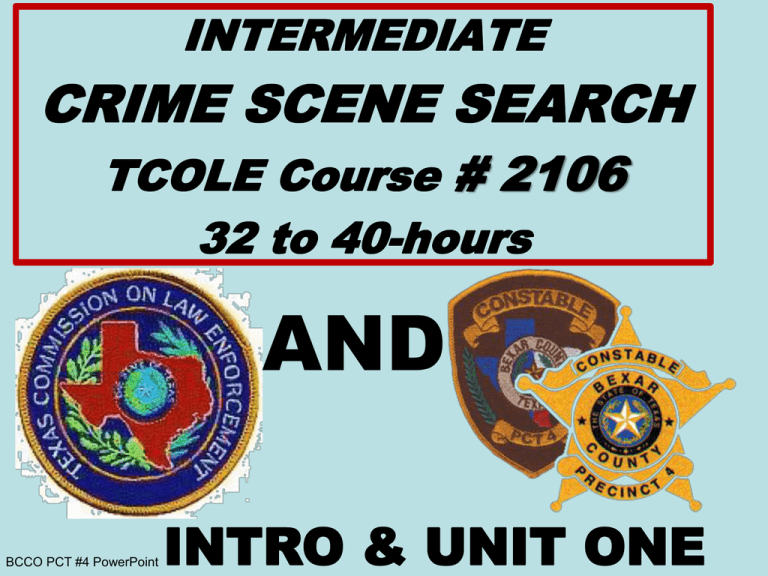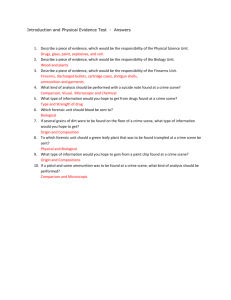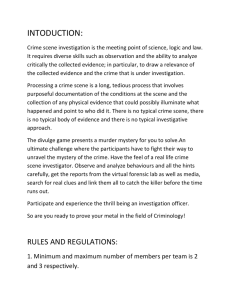Intermediate Crime Scene Search TCOLE
advertisement

INTERMEDIATE CRIME SCENE SEARCH TCOLE Course # 2106 32 to 40-hours AND BCCO PCT #4 PowerPoint INTRO & UNIT ONE ADMINISTRATIVE • Please complete the BCCO PCT #4 Registration form and turn it in now. • Make sure you sign TCOLE Report of Training (PID#, Full Name and DOB). • All cell phones off please – pay attention to course materials and show common respect & courtesy. About Your Instructor Course Facilitator - Mentor George D. Little A.S. & B.S. Criminal Justice & Sociology B.S.CJ Wayland Baptist University, San Antonio M.S. Criminology & Counter-Terrorism University of the State of New York 2012 T.C.L.E.O.S.E. Professional Achievement Award Certified Crime Prevention Specialist (C.C.P.S.) TCLEOSE Basic Instructor Certificate 1984 TCLEOSE Master Peace Officer 1991 MP Special Operations Operator Counter-Terrorism 1988 Graduate Drug Enforcement Administration Academy 1977 42- years Law Enforcement Experience 39-Years Teaching & Instructor Experience FORWARD The Intermediate Crime Scene Search Course is designed to provide additional information on this subject area. This course is one of the seven courses required for Intermediate certification. It is not meant to override department policy and current laws. Course Overview 1.0 Legal Aspects of a Crime Scene Search 2.0 Preparing for a Crime Scene Investigation 3.0 Investigating a Crime Scene 4.0 Sketching & Photographing 5.0 Fingerprinting 6.0 Identification, Collection, and Preservation of Evidence Course Overview Continued 7.0 DNA Evidence 8.0 Specific Crime Scene Searches 9.0 Simulated Crime Scene 10.0 Computer and Other Electronic Evidence Final TEST you must score 70% or higher to pass this course. Learning Objectives Learning Objective 1.1 The student will be able to summarize the legal aspects of a crime scene search. Learning Objective 1.1.1 The student will be able to explain certain objectives and legal obligations that must be followed during a crime scene search. Learning Objective 1.1.2 The student will be able to identify related constitutional and criminal laws related to a crime scene search. Learning Objective 1.1.3 The student will be able to define a search warrant. Learning Objective 1.1.4 The student will be able to describe certain requirements of a search warrant. Learning Objective 1.1.5 The student will be able to discuss search warrants according to Texas statutes. Learning Objective1.1.6 The student will be able to explain some advantages of using a search warrant Learning Objective 1.1.7 The student will be able to explain some exceptions of a warrantless search. Learning Objective 1.1.8 The student will be able to explain some justifications for denying unauthorized persons access to a crime scene. UNIT 1.0 Legal Aspects of a Crime Scene Search 1.0 Legal Aspects of a Crime Scene Search A. Objectives of a crime scene search. 1. A crime scene search is a _______ and ___________ legal search of a crime scene to locate ________ ________ or _________ to the crime under investigation. 2. The objectives in conducting a search of a crime scene are to aid in the following: Objectives of a crime scene search (2.) a. Can help establish that a _____ has been committed. (i.e., identify the type of crime and establish the elements of the crime.) b. Can be used to place the _______ at the scene (i.e., shoe impressions may match those of a known suspect in the community.) c. Can be used to _________ persons, such as through DNA testing. Objectives of a crime scene search (2.) d. Can cause suspects confronted with physical evidence to _______ the crime. e.Witness’s testimony can be supported with ________ evidence. f.Can help establish _____ the crime was _________? ____ the crime was committed (M.O ____ the crime was ____ the crime was committed (motive)? committed? B. Follow the Law. 1. _____, ____, and ______ laws must be abided to ensure admissibility of evidence in a court of law. 2. This can be done by keeping up to date with ______ ____ and ______ ______, as well as communicating with legal authorities. 3. Determine the need of a ______ _______ Continued: 4. If the crime scene does not fall under your agency’s jurisdiction, ________ the __________ and contact appropriate agency. C. Secure the Remains 1. Ensure the _____ is _______ by supervising the labeling, packaging, and removal of the remains. 2. Ensure the appropriate __ tag is placed on the ____ to preclude misidentification upon receipt at the examining agency. 3. Ensure all potential _________ is safe-guarded and property and clothing remain on the body. 4. Prior to leaving the scene, ensure the body is ________ from further trauma or contamination, and unauthorized removal of therapeutic and resuscitative equipment. 5. Ensure all ________ of the person 6. Ensure all ___ samples are recovered. 7. Ensure the ____ is properly placed in the bag. 8. Maintain _________ over the _____, and record any transactions. 9. Ensure appropriate officials sign the _____ __________ and other respective documents. D. Notify next of kin 1. Next of kin of a deceased victim (s) should be notified as soon as ________. 2. Notification initiates ________ for the family, disposition of remains, and facilitate the collection of additional information relative to the case. 3. Inform the family of the following: a. If an autopsy is required. b. Available _______ ________ (e.g. victim assistance, police, social services, etc.) c. Appropriate ________ to contact with questions or additional information. d. Ensure the family is not left alone with the _____ Continued: 3. Inform the family of the following: e. Provide a timetable of how/when the victim’s information will be released (toxicology results, etc.) f. Inform family of available reports, including costs, if any. U.S. Constitutional and Criminal Laws A. Due process, U.S. Constitution, & Bill of Rights. 14th Amendment – three classes of rights: a.) __________ and _________ of citizens of the U.S., b.) ___ _______ of law, and c.) ____ protection under the law. A. Due process, U.S. Constitution, and the Bill of Rights….cont’d: 2. 4th Amendment – unreasonable ________ and _______ clause; ________ clause. 3. 5th Amendment – __________________ clause. 4. 6th Amendment – right to ____________ clause; right to _______ clause. Continued: B. Legal issues for searches. 1. Probable cause. 2. Exclusionary rule. 3. Fruit of the Poison Tree Doctrine (___ _______) a. Silverthorne Lumber Co. v. United States, 251 US 385 (1918) 4. Search incident to lawful arrest. a. Chimel v. California, 395 U.S. 752 (1969) b. Maryland v. Buie, 494 U.S. 325 (1990) c. United States v. Sokolow, 490 U.S. 1, 7 (1989) a. Nix v. William, 467 U.S. 431 (1984) Continued: 5. Good faith exception. a. United States v. Leon, 468 U.S. 897 (1984) b. Massachusetts v. Sheppard, 468 U.S. 981 (1984) c. Illinois v. Rodriguez, 497 U.S. 177 (1990) Continued: 6. Inevitable discovery doctrine. a. Nix v. William, 467 U.S. 431 (1984) 7. Computer errors exception. a. Arizona v. Evans, 514 U.S. 1 (1995) 1.1.3 Definitions A. Definition of a ______ _______ (or ______-and-_______ warrant)– a judge’s written order authorizing a law enforcement officer to conduct a search of a specified place and to seize evidence (SOURCE: Black’s Law Dictionary, 7th Ed., 1999, West Group, Inc.) B. Specific types: 1.Anticipatory – based on an affidavit showing ________ _____ that evidence of a certain crime will be located at a specific time and place, at a future date B. Specific types: 2._________ – authorizes officials to search more than one area; serves as an unconstitutional warrant authorizing the _______ of __________ found at a given location, without specifying which items may be seized. B. Specific types: 3. __-_____ – authorizes officials to enter premises without ________ and __________ their presence and purpose before entry (a prior announcement would lead to a destruction of items searched for or would endanger the safety of the police or another person). 1.1.4 Requirements of a Search Warrant A. In order for a warrant to be ______, it must meet: 1.) _____________ guidelines, 2.) _____ requirements, 3.) the authorization of a __________, and 4.) contain ______ information. B. Once a warrant is authorized, it must be _________ promptly; other items of contraband/evidence should not be sought, unless they are specified in the warrant. Items seized, other than those specified in the warrant, are not considered “within the scope of the search” and will probably be excluded from the trial, as evidence obtained illegally. C. The search process consists basically of three stages: 1) the __________, 2) _______ of the search warrant, 3) and the ______ ______ return. 1.1.5 Search Warrants According to TEXAS Statutes A. Definition of search warrant CCP 18.01 B. Grounds for issuance CCP 18.02 C. Issuance of search warrant to photograph injured child CCP 18.021 D. Search warrant may order arrest CCP 18.03 E. Contents of warrant CCP 18.04 F. Execution of warrants CCP 18.06 G. Days allowed for warrant to run CCP 18.07 H. Power of officer executing warrant CCP 18.08 I. Shall seize accused and property CCP 18.09 J. How return made CCP 18.10 K. Custody of property found CCP 18.11 L. Disposition of abandoned or unclaimed property CCP 18.17 M. Disposition of gambling paraphernalia, prohibited weapons, criminal instrument, and other contraband CCP 18.18 N. Disposition of explosive weapons and chemical dispending devices CCP 18.181 O. Deposit of money pending disposition CCP 18.183 P. Disposition of seized weapons CCP 18.19 Q. Interception and use of wires, oral, or electronic communications - Definitions CCP 18.20 R. Testing for communicable diseases following certain arrests CCP 18.22 1.1.6 Advantages of using Search Warrants A. Has proved to be one of the most valuable ___s in criminal investigation. B. Some of its many uses include: 1. To recover _____ property; seize ______ or other contraband 2. To seize any other _______ type of property used in the commission of a crime. C. Evidence seized through the use of a search warrant may be more readily ________ by ______ than if seized without a warrant or incident to arrest. D. An officer may be protected from _____ _________. E. May shift the _____ ______ to the defendant to show that the evidence was seized illegally. 1.1.7 Exceptions of a warrantless search 1.1.7 1. Consent. • Florida v. Royer, 460 U.S. 491 (1983) • Bumper v. North Carolina, 391 U.S. 543 (1968) • Schneckloth v. Bustamonte, 412 U.S. 218, 93 S. Ct. 2041, 36 L. Ed. 2d. 854 (1973) • Florida v. Jimeno, 500 U.S. 248 (1991) 2. Emergency (exigent circumstances) . • ______. 1.1.7 • Threat of the suspect ________. • Threat of the removal or ________ of ________ (e.g. flushing it down the toilet). 1.1.7 2. Emergency (exigent circumstances) Relevant case law: • Ker v. California, 374 U.S. 23, 42 (1963) • Cupp v. Murphy, 412 U.S. 291 (1973) • Warden v. Hayden, 387 U.S. 294, 303 (1967) • Mincey v. Arizona, 437 U.S. 385 (1978) • Wilson v. Arkansas, 514 U.S. 927 (1995) 3. Incident to lawful arrest. 1.1.7 New York v. Belton, 453 U.S. 454 (1981) 4. Stop-and-frisk. • To investigate ____________ circumstance. • To make identification of a ______. • Relevant case law: Terry v. Ohio, 392 U.S. 1 (1968) Minnesota v. Dickerson, 508 U.S. 366 (1993) 5. Plain-view. 1.1.7 a. United States v. Henry (1958) b. Harris v. United Stated, 243 F. 3d 806 (1968) c. Coolidge v. New Hampshire, 403 U.S. 433 (1971) d. Horton v. California, 496 U.S. 128 (1990) e. Michigan v. Tyler, 436 U.S. 499 (1978) f. Mincey v. Arizona, 437 U.S. 385 (1978) g. Texas v. Brown, 460 U.S. 730 (1983) h. United States v. Irizarry (1982) 6. Automobile. 1.1.7 a. Carroll v. United States, 267 U.S. 132, 153 (1925) b. New York v. Belton, 453 U.S. 454 (1981) c. United States v. Ross, 456 U.S. 798 (1982) d. California v. Acevedo, 500 U.S. 565, 114 L. Ed. 2d 619, 111 S. Ct. 1982 (1991) e. Pennsylvania v. Labron, 518 U.S. 938, 116 S. Ct. 2485 (1993) f. Wyoming v. Houghton, 525 U.S. 295, 956 P. 2d 363 (1999) Continued: 1.1.7 7. Open-field. a. Oliver v. United States, 466 U.S. 170, 181 (1984) b. United States v. Dunn, 480 U.S. 294, 304 (1987) 1.1.8 Denying Persons Access to Crime Scene A.If necessary, obtain search ______. B.Only __________ persons may enter the Crime Scene area. C.If possible have owner give ______ _________ for law enforcement to keep unauthorized persons out of crime scene area (off his/her property) Continued: 1.1.8 D. Possible justifications for denying unauthorized persons access to crime scene area are: 1) Criminal Trespass – PC 30.05 2) Tampering with or fabricating physical evidence – PC 37.09 3) Sealing premises of deceased – CCP 49.22 GOOD LUCK WITH EXPLAINING THESE TO THE MEDIA! Questions? SOURCES • DOJ Research Report, Death Investigation: A Guide for the Scene Investigator, November 1999. • DOJ Research Report, Eyewitness Evidence: A Guide for Law Enforcement, October 1999. THANK YOU STAY SAFE & STAY VILIGANT This PowerPoint and all associated lesson materials herein are the property of BCCO PCT#4








